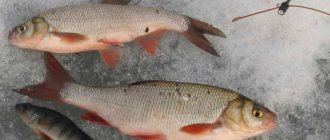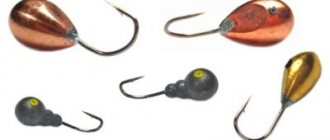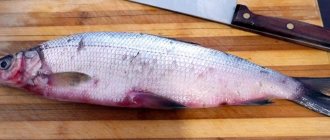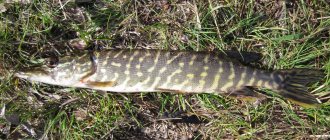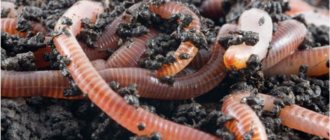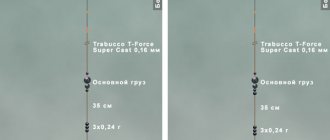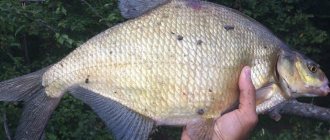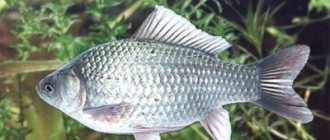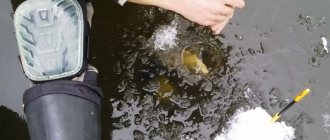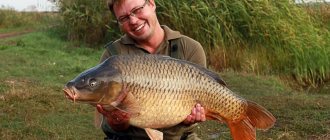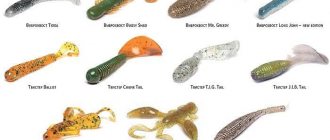Even in summer, not every fisherman manages to catch such a representative of salmon as whitefish, and in cold weather the task becomes much more difficult. This may be why the number of people wishing to mine it increases every year.
Whitefish are not roach or perch; everyone has long been tired of them. This is the same trophy that you are not ashamed to show off to your fishing friends. But catching whitefish in winter, unlike fishing for other underwater inhabitants, depends to a large extent on luck. The fact is that whitefish is a migratory fish; it does not stay in one place for long. He is in constant motion, moving around the reservoir along his favorite routes and he does not care at all about the fact that somewhere above the hole a fisherman is freezing, waiting for him. Another difficulty in catching whitefish is that it is extremely cautious and timid. He regards the slightest noise as a threat and takes the tenth road around the dangerous place.
To successfully catch it in winter, you need to know all these nuances and act accordingly. That is, set up your gear correctly, first of all fish those areas where whitefish trails can pass, use catchable baits, and behave as quietly as possible on the ice. This is the only way to hope for a good catch, and not for the accidental capture of a couple of small individuals.
Promising places
Whitefish avoids dirty and muddy areas; it prefers clean, oxygenated water. In summer, this fish often rises to the middle and upper horizons and comes closer to the shore, but in winter it is better to catch it in deep water, near the exits from the pits.
Experienced winter fishermen advise choosing places with depths of 4-5 meters. You can try your luck even deeper. In this case, bites will be rare, but the caught specimens will delight you with their size.
In winter, when the ice hides all landmarks, it is quite difficult to determine the location of whitefish trails on an unfamiliar paysite or open body of water. You have to drill a lot of holes, take measurements, study the bottom topography. By the time you find a promising point, there is no time to fish, so it is better to focus on competitors or holes left by them.
Sometimes small whitefish are caught well in the coastal zone, at a depth of no more than 2 meters. Here they look for caddis flies, bloodworms, and daphnia at the bottom. But if the goal of fishing is to catch a trophy weighing a kilogram, then it is better to drill holes in the deep central part of the reservoir.
Tackle composition
- main line;
- leashes with hooks;
- rubber shock absorber;
- nylon cord with weight;
- bite alarm;
- rope with float;
- reel or reel with a short rod.
And now, in order:
Monofilament fishing line with a diameter of 0.2 mm (crucian carp, perch) to 0.4 mm (pike perch, carp) is used as the main fishing line. The length depends on the fishing range, but sometimes an extra ten meters in reserve won’t hurt. Leaders require material with less strength than the main line. Then, when hooked, only the hook or leash will be lost, and the rest of the tackle will be preserved. Leashes are made of different lengths, ranging from 10 cm to 70 cm. This is explained by the fact that when fishing on a steep slope, it is useful to fish both shallows and deep holes. In addition, leashes should be equipped with different hooks. This will allow you to quickly switch from fishing with maggots to fishing with a worm. It is best to use shock-absorber rubber with a round cross-section for donkeys. The length of the elastic is selected in accordance with the expansion coefficient of the material and the fishing distance. Typically, fishing rubber can elongate 3-5 times. Accordingly, the fisherman will have to take these properties into account when equipping the donkey with a rubber shock absorber. The easiest way to attach a heavy load to an elastic band is to use a piece (0.5-1 m) of nylon cord. The weight can be cast from lead or made in the form of a brick
It is important that it holds the tackle at the fishing point. So that the angler can control every touch of the fish to the bait, the rubber bottom is equipped with a bite alarm. This could be a piece of a branch or an electronic bite alarm.
The main thing is that the angler knows exactly at what moment he needs to make an effective hook.
A float with a rope is used in cases where the tackle is installed using a boat. Then the float will tell the fisherman where to look for the load of gear that needs to be taken out of the water. All gear can be stored and transported on a homemade reel made of wood or foam. Sometimes anglers use inertial reels with a short rod.
Read Catching a chebak
Lure fishing
Once they reach a certain age, whitefish become predators. Their diet, which previously consisted mainly of small animals, is replenished with fry. Therefore, if there are medium and large specimens in the reservoir, excellent results can be achieved with balancers and winter lures.
Tackle for catching whitefish in winter using spoons is not particularly different from pike perch. To troll, you will need a short fishing rod equipped with an open reel and a Mylar nod, as well as a certain supply of monofilament (for fishing a large whitefish - 0.18-0.2 mm, for a medium one - 0.14-0.16). Sometimes, if the bite is too weak, it is useful to replace the standard fishing line with a thinner one.
In recent years, fishermen are increasingly using winter spinning rods up to 50 cm long to catch whitefish from the ice. They are equipped with lightweight spinning rods and a braided cord with a diameter no thicker than 0.12 mm. Since braid can scare away fish, an invisible fluorocarbon leader must be tied to its end. Of course, on frosty days it is not very convenient to use the cord, since it freezes heavily, but when fishing at great depths, thanks to it, the tackle acquires the necessary sensitivity.
As already mentioned, the baits for such fishing are spoons and balancers.
A hungry whitefish will take any lure, but it still has its own preferences. The best “provocateurs” are considered to be elongated silver spoons that look like a small fish.
Two-tone models work well, with one side silver and the other gold. The size of the bait ranges from 4-7 cm.
There is an opinion that for big fish you need to put a larger bait, but for whitefish this rule is not relevant. It happens that a real “monster” that does not fit in the hole takes a miniature spinner. To make it more attractive, the tee of the whitefish spoon is equipped with bright plumage - a bunch of red threads. If it has a single hook, then its fore-end can be decorated with colored beads or cambrics.
The balancer is another effective bait for catching whitefish from the ice. As a rule, small products up to 5 cm long, painted in natural colors, are used. For example, gray, silver, blue or a combination of them. The size and weight of the balancer are selected taking into account fishing conditions, especially depth.
Flashing whitefish does not imply and even excludes high sharp strokes with a fishing rod, as when catching perch or pike perch. This might scare him away. The spoon is stopped 10 cm above the bottom, and then it is smoothly thrown up to the same height and the fishing rod is immediately returned to its original position. After a 5-second pause at the bottom point, a short swing again and so on. If the fish ignores the bait in the water column, you can play with it on the bottom: move it, knock on the surface, raise a little mud and slowly lift it. Most often, a bite occurs at the moment of stopping.
Whitefish fishing tactics
The first step when fishing for whitefish is to decide on the right fishing spot. If you determine where the whitefish routes through the reservoir, this will help save time and make fishing productive and not a waste of time. Having old holes can simplify the task and you can try fishing on them first. Or make new ones nearby if the old ones are very frozen. If there is no bite, then suitable places will have to be determined experimentally by studying the reservoir.
As soon as the place is found, the angler should make himself comfortable and first throw a little bait into the hole to keep the fish near him. Then they begin the fishing itself. To begin with, they try to catch near the bottom, then the bait is gradually raised up, gradually passing and exploring all the depths. At the depth at which whitefish begin to bite, you should continue fishing at that depth.
An important condition will be to maintain silence. There is no need to walk, fidget, talk on the phone or talk loudly with neighbors. All this will easily scare away the whitefish, and it will simply go to other places.
The whitefish bite is confident and sharp. As soon as the whitefish attacks the bait, it tries to immediately go to depth. You should hook it right away and try to immediately pull it onto the ice. Fishing for a whitefish for a long time can scare away other fish, and the bite may stop.
Whitefish vigorously resists when fished, especially near the hole itself. And to remove large specimens, you may need a hook, which an angler must have on such fishing.
Fishing with a jig
Catching whitefish in winter with a jig deserves special attention. The most common gear used in this kind of fishing is either a fishing rod with an open reel, or a so-called balalaika, in which the reel is hidden in the body. The nod is lavsan or metal. The fishing line used is monofilament; the ideal option would be fluorocarbon monofilament, since it is practically invisible in water. To ensure that fishing does not bring disappointment, the thickness of the fishing line must be selected in accordance with the size of the fish. For small whitefish - 0.12-0.14 mm, for individuals weighing up to a kilogram - 0.16-0.18 mm.
Whitefish are caught with fairly heavy dark-colored jigs. Their shape does not play a special role; it can be a drop, an oatmeal, a shot or any other classic jig.
Several bloodworms, maggots, jigs or worms are placed on the hook. If the target is highly active, you can do without bait altogether, using colored beads and cambrics instead.
Jigs for whitefish
Any angler who has mastered the simple technique of swinging the rod can catch whitefish with a jig. They begin to play with bait in the bottom layer, periodically tapping it on the ground. If there are no bites, you should reel in a little fishing line and play a little higher. The height is increased until the fish responds and it becomes clear in which horizon it is feeding. If several individuals were pulled out of one hole, but then the bites stopped, this does not mean that the flock has left. Perhaps she sank to the very bottom or, conversely, rose higher.
Instead of a jig, fishermen often use a summer version of the equipment - a sliding weight, limited by stoppers, and a hook. It must be sharp, capable of piercing the hard palate, otherwise there will be more derailments than successful hooks. The fishing rod remains the same.
Basic rules for catching whitefish
- In winter, fish such as whitefish are caught using simple gear. Do not overload her with all sorts of tricks and wisdom. After all, the simpler the tackle, the easier it is to handle in cold conditions.
- The fishing line you need is strong, elastic 0.12-0.08 (this is a very delicate tackle), a sensitive nod, small jigs: dark on the bottom, small light on top. The most universal combination is a devil on top and a small black jig on the bottom.
- Whitefish are also caught with orange beads on the hook, which imitate caviar, which he loves. It is also caught on maggots and bloodworms.
- It is necessary to feed the fish a little in the hole.
- You don’t need to wrap too much fishing line around the reel, otherwise it will simply get tangled and freeze, causing a lot of inconvenience. 10 meters will be enough.
- Jigs for whitefish are selected in the form of a comma, silver or light yellow. Experienced fishermen advise using a kind of tandem: a small silver jig at the bottom, and a fly 15 cm above it.
You should have fishing rods with jigs for whitefish. They should be shaped like a large comma. They are made from the same material as spinners. The following baits are used: earthworms, maggots, bark beetle larvae, bloodworms. It is worth remembering that mostly small whitefish are caught with bait such as bloodworms. It is better to use amphipods and mayfly nymphs of gray or brown color as bait.
Read Salmon Fishing
In winter, it is better to take jigs for whitefish in the shape of a ball or drop-shaped, two-colored ones. The right tackle and bait, a good fishing spot, will undoubtedly bring results.
As complementary food, you can take millet mixed with flavorings. The holes must be drilled at a small distance from each other.
Catching whitefish with a jig is a cultural sport and a very popular form of recreation, however, it requires special skills, endurance, the body’s adaptation to low temperatures and physical strength. After all, if the fishing spot is chosen successfully, the bite continues all day until complete darkness.
Catching whitefish with a jig in winter is quite an interesting challenge. It is common in Europe, northern latitudes, in places with good access to food. There are many subspecies of whitefish, some are even listed in the Red Book. It loves insect larvae, crustaceans, mollusks, eggs of other fish and sometimes eats its fellows. When going fishing for whitefish in winter, you should take with you not only a jig, but an ice auger, bait, a winter fishing rod, a lure, a hook, and a fish bucket. Also, if you fish with a float, then an article on how to attach a float to a fishing line will be very helpful!
A jig for whitefish is a necessary attribute, but when arming yourself for fishing in the winter, you should not forget about your own safety measures. Take warm clothes, hot tea, coffee, food with you. Fishing in winter is a great vacation and all these things will help you spend it usefully and comfortably.
We recommend reading:
Lure
After discovering a school, the fisherman’s main task is to keep it under the hole. For this purpose, bait is used, which is fed in small portions and creates a vertical feed column in the water. For whitefish, it is much more attractive than a food spot blurred on the bottom. The pace of feeding directly depends on the intensity of the bite, so the angler needs to be careful. Often you have to work with both hands: hold the fishing rod with one, and throw bait balls into the hole with the other.
Why is whitefish so popular?
In this article I want to talk about whitefish fishing, its details and about those who like to catch this fish. There are many such lovers on the Kola Peninsula for several reasons. One of them is the accessibility of whitefish lakes and rivers flowing through them. They, as a rule, have a short distance from cities and from the roads connecting them.
Well, it’s also important that whitefish’s companions in lakes can be trout, burbot, and perch. And if suddenly, without any jerk after hooking, you lose your favorite jig, then rest assured that a toothy pike took it.
Winter bait and groundbait for whitefish
As bait for winter whitefish fishing, you can use: Probably the best bait for catching whitefish in winter is a jig. When it looks like a jig, the whitefish cannot resist and pounces on the bait. It should be noted that mainly small-sized whitefish are caught with bloodworms, therefore it is recommended to lure with gray mayfly nymphs or amphipods. You can feed the fish with millet mixed with aromatic additives. Despite the fact that a predator is not against eating the eggs of many species of fish, it is not recommended to use bait in the form of eggs. A smart predator will immediately suspect something is wrong, because spawning of most species occurs in the autumn or spring.
Complementary feeding rules
The main thing in the process of catching whitefish in winter is to notice the school and keep it in one place for as long as possible. To do this, a small amount of complementary food is thrown into the hole, the next portion of which is sent into the water after the previous one disappears from sight. As a result, something like a vertical column of bait is formed - this method is much more attractive to fish than the accumulation of food at the bottom. Of course, this requires a lot of effort and attention from the fisherman, but the game is worth the candle. Changing the bait regime has a good effect on the catch results, since playing with bait in winter is much more difficult. To do this, various intervals are made between feeding feeds, and the size of the bait is adjusted, for example, first a small bloodworm is thrown, then a large one. The resulting oscillation of the nod can have many causes - from the fishing line touching to the shock of the nozzle. It is very difficult to distinguish such movements from a bite, and even an experienced fisherman cannot always cope with such a task. Most of all, if there are too many fluctuations, it means that the village has risen from the bottom. This, in turn, requires searching for new fishing horizons through extensive experience. You can determine the working level by timing the time between the next bait cast and the oscillation of the nod. The operation is repeated many times with a gradual decrease in descent, which, like the place and time, must be remembered. Due to the stability of the migration of plankton, which whitefish feed on, the proven fishing scheme will be effective even after a year, next winter.
We fish in winter. Fishing for whitefish
Fish like whitefish are difficult to catch even in summer. In winter, this member of the salmon family becomes even more difficult to catch. Perhaps it is precisely because of these difficulties that more and more people like to catch whitefish in winter.
Whitefish is not that everyday little thing in the form of perch or roach, which are found almost everywhere and always and which are not at all difficult to catch. Any fisherman can deservedly boast of catching a whitefish over other fishermen. Catching whitefish in winter is a difficult task and depends more on luck than on good equipment or great fishing experience. Whitefish does not stay in one place all the time. Whitefish do not have their own sites. He constantly moves along his favorite routes across the pond. And whitefish is a cautious fish and does not like noise. And if suddenly the whitefish hears any noise, it will simply bypass this place. And the fisherman may simply be left without fish.
You need to know all these features of whitefish fishing and organize all your fishing in a suitable way. And you need to behave quietly, not make noise, not rattle on the ice. And the gear should be carefully selected and adjusted in advance specifically for catching this fish. Particular attention should be paid to choosing a place where there may be those favorite underwater whitefish trails. Only in this way can one hope that the whitefish will bite and the fisherman will not be left completely without a catch.
When to catch whitefish in winter
The greatest activity in whitefish species is observed at the beginning of winter, then it subsides a little, but continues to peck all winter with the right approach. Whitefish can be caught weighing up to 1 kg. When fish are released into a pond, they gather in schools. It (the flock) consists of different species and individuals of different sizes. It is not uncommon for trout to attach themselves.
Before the first ice, for two weeks, every day, they took Whitefish to Shabrovsky Pond! Each batch is 300-500kg! All the fish were released into the main reservoir!
Fishing in the Sverdlovsk region on the Shabrovsky pond Shabrovsky pond - Paid Fishing in Yekaterinburg Recreation by the pond | Fishing | Smoked fish | Rent of gazebos www.shabry.ru https://vk.com/shabryru tel: +79220334432 (Administrator’s working hours from 8:00 to 22:00) Address: Ekaterinburg village. Shabrovsky st. Sadovaya 15

